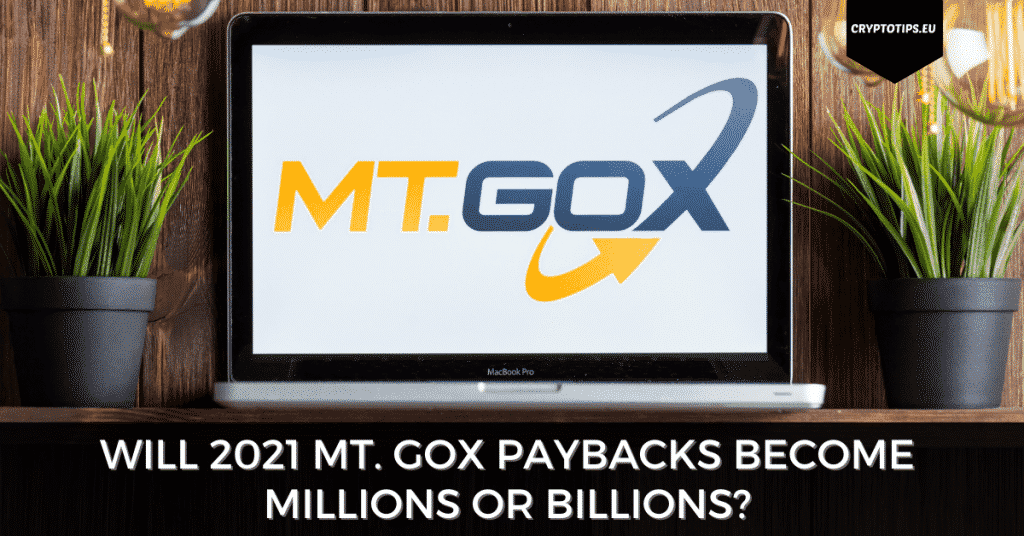Will 2021 Mt. Gox Paybacks Become Millions Or Billions?
Last Updated on 23 March 2021 by CryptoTips.eu
All those wanting to link Bitcoin to crime will tell you two names: Silk Road and Mt. Gox. The former, Silk Road, was a darknet website setup by Ross Ulbricht which allowed for the illegal sale of substances on the internet, and Bitcoin was used as its currency.
The latter, Mt. Gox, was for a long time the main Bitcoin exchange platform. It was setup shortly after Bitcoin celebrated its second birthday and at its peak, it was responsible for no less than 80% of Bitcoin’s trading volume.
Initially, it was a site where card game fanatics of Magic: The Gathering, could trade their cards on the internet. In 2007 programmer Jed McCaleb (who would go on to work for Ripple Labs and then founded Stellar) bought the mtgox.com domain.
A few years later, in 2010, he changed it to a Bitcoin market, the first of a kind. In March 2011, he sold it to Mark Karpeles in return for a half year’s earnings.
He had to give me half of the first six months’ revenue then I continued to own 12% of it
McCaleb said. By now, the Stellar founder no longer has any stake in Mt. Gox. You can read the full story in our Mt. Gox overview.
Hacks
Unfortunately, it was hacked twice in 2011 and 2014, resulting in the loss of $ 1.35 million in Bitcoin, or some 850,000 Bitcoins in all at the time. At today’s price, it would make for a phenomenal amount.
However, just as the mystery of Bitcoin’s creator Satoshi Nakamoto remains unsolved, so does the hacking of Mt. Gox.
Eight years later, a major step in the bankruptcy proceedings that have ensnared Mt. Gox and its users after the market imploded in 2014 took place. A deal has now been announced that will allow creditors to get some of their money back before the case is decided.
Lucky for them, all the Bitcoins that were recuperated have been HODLed since 2014.
Draft rehabilitation plan
Some of the Bitcoins lost or stolen from Mt. Gox have since been found, and the Japanese bankruptcy trustee Nobuaki Kobayashi is working to reimburse creditors. He has now proposed a plan. On December 15 last year he proposed a draft rehabilitation plan aimed at reimbursing users injured by the platform hack.
Earlier this week, according to the official announcement made by Nobuaki Kobayashi on February 25, the Tokyo court approved the proposed plan.
An excerpt from this plan reads:
The following is the schedule prescribed by the Order: (1) Record date for determining voting rights holders: March 24, 2021 (Wednesday) (2) Deadline for notice of non-uniform exercise of voting rights: September 10, 2021 (Friday) (3) Deadline for online voting and voting by mail: October 8, 2021 (Friday) (4) Creditors’ meeting for resolution on the Draft Rehabilitation Plan: October 20, 2021 (Wednesday), from 14:00 onwards
As part of this plan, creditors will be consulted during a vote to approve the rehabilitation plan. First, the proxy will determine the creditors eligible for this vote. Thereafter, they will have from March 24 to October 8 to vote, online, by mail or in person on the day of the creditors’ meeting scheduled for October 20.
In total, aggrieved users will be distributed some $630 million and 150,000 BTC remaining from the Mt. Gox bankruptcy fund.
Depending on what worth those 150k Bitcoin have in October of this year and how many each of them will receive, that could be millions or even billions deposited to their bank accounts.
burdun / Depositphotos.com
